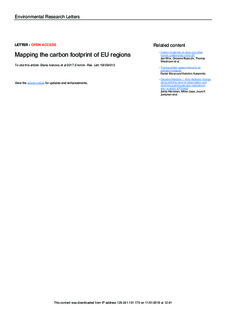| dc.contributor.author | Ivanova, Diana | |
| dc.contributor.author | Vita, Gibran | |
| dc.contributor.author | Steen-Olsen, Kjartan | |
| dc.contributor.author | Stadler, Konstantin | |
| dc.contributor.author | Melo, Patricia C | |
| dc.contributor.author | Wood, Richard | |
| dc.contributor.author | Hertwich, Edgar G. | |
| dc.date.accessioned | 2018-03-09T09:23:23Z | |
| dc.date.available | 2018-03-09T09:23:23Z | |
| dc.date.created | 2017-04-27T13:36:44Z | |
| dc.date.issued | 2017 | |
| dc.identifier.citation | Environmental Research Letters. 2017, 12 (5), . | nb_NO |
| dc.identifier.issn | 1748-9326 | |
| dc.identifier.uri | http://hdl.handle.net/11250/2489665 | |
| dc.description.abstract | While the EU Commission has encouraged Member States to combine national and international climate change mitigation measures with subnational environmental policies, there has been little harmonized effort towards the quantification of embodied greenhouse gas (GHG) emissions from household consumption across European regions. This study develops an inventory of carbon footprints associated with household consumption for 177 regions in 27 EU countries, thus, making a key contribution for the incorporation of consumption-based accounting into local decision-making. Footprint calculations are based on consumer expenditure surveys and environmental and trade detail from the EXIOBASE 2.3 multiregional input-output database describing the world economy in 2007 at the detail of 43 countries, 5 rest-of-the-world regions and 200 product sectors. Our analysis highlights the spatial heterogeneity of embodied GHG emissions within multiregional countries with subnational ranges varying widely between 0.6 and 6.5 tCO2e/cap. The significant differences in regional contribution in terms of total and per capita emissions suggest notable differences with regards to climate change responsibility. The study further provides a breakdown of regional emissions by consumption categories (e.g. housing, mobility, food). In addition, our region-level study evaluates driving forces of carbon footprints through a set of socio-economic, geographic and technical factors. Income is singled out as the most important driver for a region's carbon footprint, although its explanatory power varies significantly across consumption domains. Additional factors that stand out as important on the regional level include household size, urban-rural typology, level of education, expenditure patterns, temperature, resource availability and carbon intensity of the electricity mix. The lack of cross-national region-level studies has so far prevented analysts from drawing broader policy conclusions that hold beyond national and regional borders. | nb_NO |
| dc.language.iso | eng | nb_NO |
| dc.publisher | IOP Publishing | nb_NO |
| dc.rights | Navngivelse 4.0 Internasjonal | * |
| dc.rights.uri | http://creativecommons.org/licenses/by/4.0/deed.no | * |
| dc.title | Mapping the carbon footprint of EU regions | nb_NO |
| dc.type | Journal article | nb_NO |
| dc.type | Peer reviewed | nb_NO |
| dc.description.version | publishedVersion | nb_NO |
| dc.source.pagenumber | 13 | nb_NO |
| dc.source.volume | 12 | nb_NO |
| dc.source.journal | Environmental Research Letters | nb_NO |
| dc.source.issue | 5 | nb_NO |
| dc.identifier.doi | 10.1088/1748-9326/aa6da9 | |
| dc.identifier.cristin | 1466938 | |
| dc.description.localcode | Original content from this work may be used under the terms of the Creative Commons Attribution 3.0 licence. Any further distribution of this work must maintain attribution to the author(s) and the title of the work, journal citation and DOI. | nb_NO |
| cristin.unitcode | 194,64,25,0 | |
| cristin.unitname | Institutt for energi- og prosessteknikk | |
| cristin.ispublished | true | |
| cristin.fulltext | original | |
| cristin.qualitycode | 1 | |

